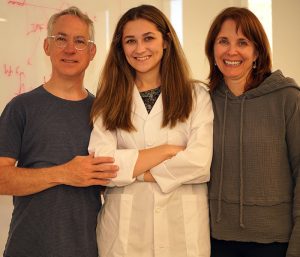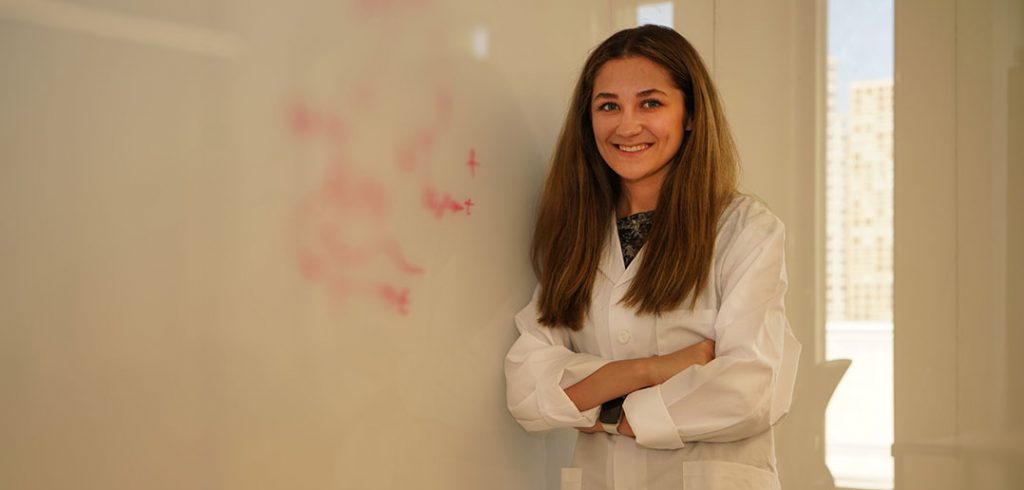“Depression is very misunderstood,” she said. “If we can figure out an exact chemical path to understand why this happens in the brain, then we can come up with better treatment plans and better medications.”
This past summer Reisner, a sophomore biology major in the Department of Natural Sciences at Fordham College at Lincoln Center, mapped neurons in the brain associated with motivated behavior. The research was conducted at Columbia University as part of a program sponsored by Fordham’s Office of Research that matches students with other New York-based institutions. Officially known as the Fordham-Columbia, Fordham-NYU and Fordham-IBM Research Fellow and Research Intern Program, the effort promotes research collaborations between the four institutions.
“We are using this kind of program to find connections between students and outside research opportunities to make sure we retain best and the brightest,” said George Hong, Ph.D., chief research officer for the University.
This year, the collaborative research program focuses on five specific areas of study: neuroscience, cybersecurity, social innovation, global studies, and urban studies. Hong said he met Reisner at an award ceremony and was very impressed with her enthusiasm for research.
“The students in the program are very enterprising and sometimes we need to find innovative ways to expand our resources to support them,” said Hong.
Reisner’s research was supervised by Eduardo Gallo, Ph.D., assistant professor of biological sciences at Rose Hill, and Christoph Kellendonk, Ph.D., an independent investigator in the Departments of Pharmacology and Psychiatry at Columbia. The project is in its intermediate stages and the scientists hope to have preliminary results this fall.
“A lot of times students are looking to do research and while we cover many different scientific disciplines at Fordham, they may not find a lab that matches their interest,” said Gallo. “They want to get their hands on their topics of interest. I’ve seen it. It reenergizes their passion for science when they do.”
Gallo said the program’s benefits have been two-fold: it provides support for the lab to undertake new research topics and it provides students with a funding opportunity to do research over the summer.
“This has allowed us to work with a lab where they do these types of projects routinely, students learn those techniques and bring them back to Fordham,” said Gallo. “This helps foster collaboration, and the scientists there see we have strong labs and talented students.”
Gallo, whose lab is at Rose Hill, said the program also helps foster collaboration across the University, providing the means for Reisner to work in labs on both campuses in addition to Columbia.
“She’s a Lincoln Center student so this mechanism also provides the opportunity for her to travel up here to Rose Hill and be a part of my lab, where she also does her work and interacts with Rose Hill students,” said Gallo.
Jason Morris, Ph.D., chair of the Department of Natural Sciences at Lincoln Center, agreed that both campuses are benefiting from the program.
“In addition to all the student research we mentor here at Lincoln Center, we’ve had several of our students in this program this year. In years past we’ve had informal arrangements with major research institutions around New York, so we are very pleased that the Research Office is formalizing some of those relationships,” said Morris.
Mapping it Out
Reisner’s specific area of interest deals with mapping physical connections in the brain.
“By mapping the connections, I hope to understand the energizing of behavior in pursuit of a goal,” she said. “For example, overcoming obstacles to obtain food and water, or working hard all semester long to get A’s.”
In the brain, the ventral pallidum and nucleus accumbens are regions critical for many types of motivated behavior. While there is evidence linking them to motivation, little is known about the function of the different neurons within them and how they connect to the rest of the brain, she said. Specifically, she’s focused on cholinergic projection neurons of the ventral pallidum in an attempt to figure out which neurons throughout the brain connect to them specifically.
“If we know who sends information to them, we can then study what the function of that connection is,” she said.
To create a visualization of the map, the general practice is to inject a genetically engineered virus that infects the cholinergic neurons to make them glow with a fluorescent protein that helps in the visualization. The virus then jumps only to cells directly contacting them and those cells, in turn, express the fluorescent protein.
“We can then look for fluorescent neurons all over the brain and establish where they are located and what kind of information they may be passing along to the cholinergic cells,” she said. “Piecing this together may help us understand not only how motivated behavior works, but also may provide clues on how to alter it in cases where it is maladaptive, as in drug abuse, depression, ADHD, schizophrenia, and other disorders.”
Gallo concurred.
“In the field, we have a saying, ‘Neurons that fire together wire together.’ In the future this study may provide a map on where we need to focus, where we see robust connections of the neurons of interest,” said Gallo. This may open many new research avenues for our students.”
Researching from Experience
Reisner knows from personal experience that science and research can make a difference in the lives of people suffering from a variety of motivational disorders.
“I have really bad anxiety and I’ve struggled with it since I was a kid,” she said. “It’s a panic disorder and I’m very open about it.”
Her grandfather wasn’t as fortunate. She said that growing up in Alabama she witnessed how hard it was for him get the correct medications. She also noted how social stigma exacerbated an already difficult situation.
“I’m thankful that I’m not growing up in the ’70s and ’80s when we didn’t understand mental health as well as we do now,” she said.
Today, she said she and her family understand that mental illness is by and large genetic. She said her grandfather has good days, bad days, and some days where he doesn’t want to leave the bed.
“People thought, especially being the man of the household in Alabama—people think that you’re crazy and people think that you are incompetent,” she said. “And just the way he’s kind of overcome this and now he’s so much better is inspiring to me.”
She said that finding the right medication is key, and a key part of why she does her research. She said he went through “a million different medications and treatment plans.”
“I just wish he didn’t have to go through all of that to find what’s actually wrong,” she said. “And then for me, I relate to a lot of it with him because we struggle with a similar issue.”
Back to Work
Returning to campus just before the semester started, Reisner swung by Lincoln Center’s newly renovated lab with her parents and talked about her experience.

“At Lincoln Center, all of my science professors know my name and they know what I’m interested in,” she said. “And then at Rose Hill, I had this opportunity where I can go into a lab and they know exactly what I’m interested in studying. And then they can kind of work with me and say, ‘Okay, you’re very unique because you like this. So, how about we put you in contact with this professor,’” she said, adding that they also connected her with a professor that got her into the Fordham-Columbia program.
She said that she’s happy to be back at Fordham and appreciates the opportunity that the collaboration has afforded her.
“It’s amazing how we can be in collaboration with Columbia and I can still be in a specialized school like Fordham where everybody knows my name, everybody knows what I like to do, everybody knows my interests.”
Gallo said that being a part of a collaborative effort is an important aspect of research that must be taught alongside the science.
“The collaboration provides outcomes for our lab, but it also helps expose students to other scientists,” he said. “It’s also about talking to people and being in the mix, being a part of New York’s neuroscience community. It gives students an idea of where they want to go in the future and career possibilities they may want to explore.”


